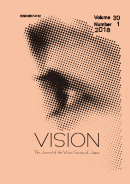
- Issue 4 Pages 203-
- Issue 3 Pages 149-
- Issue 2 Pages 115-
- Issue 1 Pages 1-
- |<
- <
- 1
- >
- >|
-
Takanori Yamazaki, Kazumichi Matsumiya, Ichiro Kuriki, Satoshi SHIOIRI2010Volume 22Issue 3 Pages 149-163
Published: 2010
Released on J-STAGE: November 29, 2018
JOURNAL FREE ACCESSSong and Nakayama reported that pointing trajectories in a numerical comparison task were influenced by internal competition processes between numeric representations [Cognition 106, 994–1003, 2008]. We tested this phenomenon in two-dimensional representations, such as a clock surface and world map. Our experiments showed that the location of numbers or countries in the representation of the clock surface or the world map influenced the trajectories of pointing task related to the clock surface or the world map. We also found that the influence of the spatial representations on the pointing trajectories for naïve observers was smaller than that for experienced observers at all the phases of the pointing trajectories. The experienced observers in our study had knowledge as to Song and Nakayama’s study but the naïve observers did not. Although this may suggest that the phenomenon found by Song and Nakayama might depend on higher cognitive processes such as knowledge, we found that low level implicit processes also play a role. More robust and clearer influence of the spatial representations on pointing trajectories was found at the earlier phase of the pointing trajectories both for naïve and experienced observers. Considering that the pointing action is implicitly and automatically controlled at the earlier phase, our results suggest that twodimensional spatial representations also influence action implicitly.
View full abstractDownload PDF (1334K)
-
Olga Daneyko2010Volume 22Issue 3 Pages 165-170
Published: 2010
Released on J-STAGE: November 29, 2018
JOURNAL FREE ACCESSIn the present study I tested the effect of stereoscopic depth on the lightness of two targets equal in size, presented simultaneously so that one target appeared in depth coplanar to the background and the other appeared floating in a frontal plane closer to the observer. When targets were equal in luminance, the target that appeared more distant from the observer appeared also more contrasted to the background: when targets were increments with respect to the luminance of the background the distant target appeared lighter than the closer one; vice versa when targets were decrements the distant target appeared darker. Results are discussed with respect to the Gestalt factor “belongingness”, and to more recent finding of the effect of perceived size on lightness in the Delboeuf and the Ebbinghaus Illusions.
View full abstractDownload PDF (373K)
-
[in Japanese], [in Japanese]2010Volume 22Issue 3 Pages 171-175
Published: 2010
Released on J-STAGE: November 29, 2018
JOURNAL FREE ACCESSDownload PDF (472K)
-
[in Japanese]2010Volume 22Issue 3 Pages 177-178
Published: 2010
Released on J-STAGE: November 29, 2018
JOURNAL FREE ACCESSDownload PDF (741K)
-
2010Volume 22Issue 3 Pages 179
Published: 2010
Released on J-STAGE: November 29, 2018
JOURNAL FREE ACCESSDownload PDF (66K)
-
2010Volume 22Issue 3 Pages 181-185
Published: 2010
Released on J-STAGE: November 29, 2018
JOURNAL FREE ACCESSDownload PDF (231K)
-
2010Volume 22Issue 3 Pages 187-201
Published: 2010
Released on J-STAGE: November 29, 2018
JOURNAL FREE ACCESSDownload PDF (424K)
- |<
- <
- 1
- >
- >|